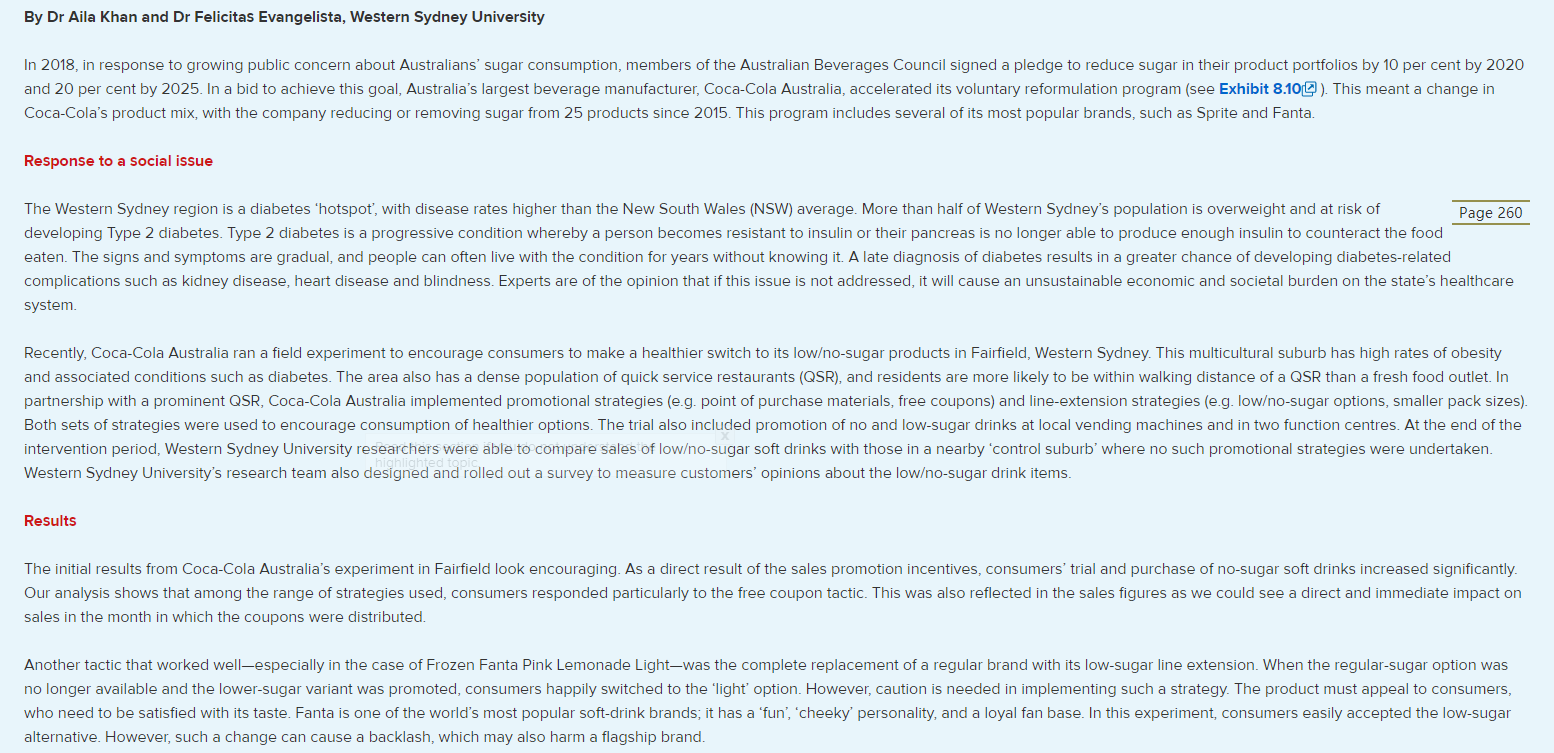By Dr Aila Khan and Dr Felicitas Evangelism, Westem Sydney University In 20l8, in response to growing public concern about Australians\" sugar consumption, members ofthe Australian Beverages Council signed a pledge to reduce sugar in their product portfolios by 10 per cent by 2020 and 20 per cent by 2025. In a bid to achieve this goal, Australia's largest beverage manufacturer, Cocaetola Australia, accelerated its voluntary reformulation program (see Exhibit qu ). This meant a change in Coca-Cole's product mix, with the company reducing or removing sugar from 25 products since ZOlS. This program includes several of its most popular brands, such as Sprite and Fanta. Response to a social issue The Western Sydney region is a diabetes 'hotspot', with disease rates higher than the New South Wales (NSW) average. More than half of Western Sydney's population is ovenNeight and at risk of W developing Type 2 diabetes. Type 2 diabetes is a progressive condition whereby a person becomes resistant to insulin or their pancreas is no longer able to produce enough insulin to counteract the food eaten. The signs and symptoms are gradual, and people can often live with the condition for years without knowing it. A late diagnosis of diabetes results in a greater chance oideveloping diabetesrelated complications such as kidney disease, heart disease and blindness. Experts are of the opinion that ifthis issue is not addressed, it will cause an unsustainable economic and societal burden on the state's healthcare system. Recently, Coca7Cola Australia ran a field experiment to encourage consumers to make a healthier switch to its lowlnoesugar products in Faireld, Western Sydney. This multicultural suburb has high rates of obesity and associated conditions such as diabetes. The area also has a dense population of quick service restaurants [05R], and residents are more likely to be within walking distance of a OSR than a fresh food outlet. In partnership with a prominent OSR, Coca7Cola Australia implemented promotional strategies [e.g. point of purchase materials, tree coupons) and lineeextension strategies (e.g. lowoesugar options, smaller pack sizes). Both sets of strategies were used to encourage consumption of healthier options. The trial also included promotion ofno and lowesugar drinks at local vending machines and in two function centres. At the end of the intervention period, Westem Sydney University researchers were able to compare sales of lowlno-sugar soft drinks with those in a nearby 'control suburb' where no such promotional strategies were undertaken. Western Sydney University's research team also designed and rolled out a survey to measure customers' opinions about the Iowlno-sugar drink items. Results The initial results from Coca-Cola Australia's experiment in Faireld look encouraging. As a direct resuft ofthe sales promotion incentives, consumers' trial and purchase of no-sugar soft drinks increased signicantly. Our analysis shows that among the range of strategies used, consumers responded particularly to the free coupon tactic. This was also reected in the sales gures as we could see a directand immediate impact on sales in the month in which the coupons were distributed. Another tactic that worked welliespecially in the case of Frozen Fanta Pink Lemonade Lightiwas the complete replacement of a regular brand with its lowesugar line extension. When the regularisugar option was no longer available and the loweresugar variant was promoted, consumers happily SWitched to the 'light' option. However, caution is needed in implementing such a strategy. The product must appeal to consumers, who need to be satised with its taste. Fanta is one of the world's most popular soft-drink brands; it has a 'fun', 'cheeky' personality, and a loyal fan base. In this experiment, consumers easily accepted the lowsugar alternative. However, such a change can cause a backlash, which may also harm a agship brand. Overall, we were able to calculate a signicant decrease in sugar consumption due to the planned migration of consumers from fullesugar soft drinks to Iowfnoesugar options. This eld experimentia major departure from using more commonly known research methods only, such as market surveysprovided concrete evidence of actual consumer behaviour, Since such experiments are time-consuming, costly and difcult to administer, these have a low penetration into marketing research practice. CocaCoia Australia should be commended for taking this methodological shift








